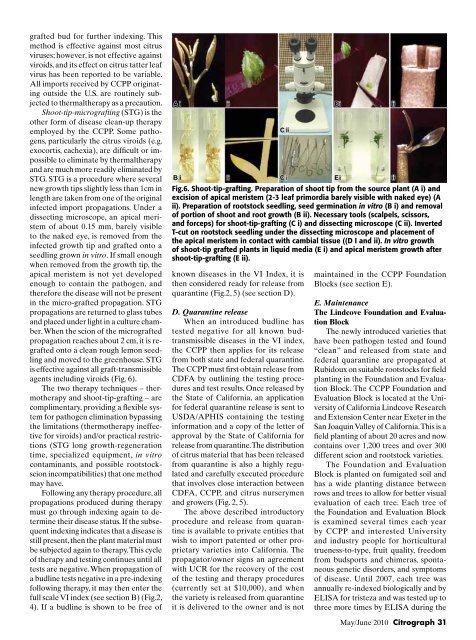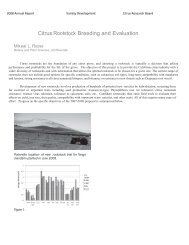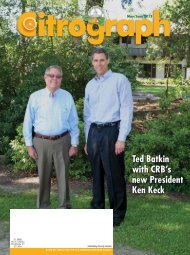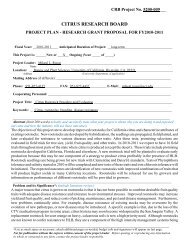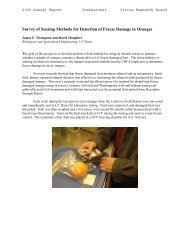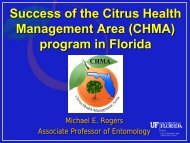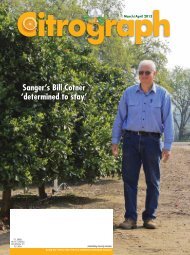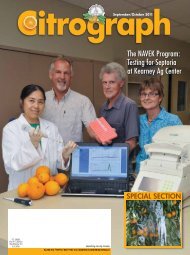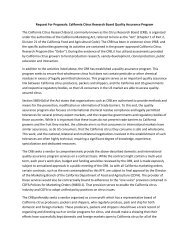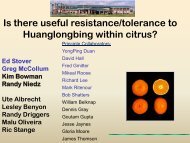Citrograph May-June 2010 - Citrus Research Board
Citrograph May-June 2010 - Citrus Research Board
Citrograph May-June 2010 - Citrus Research Board
You also want an ePaper? Increase the reach of your titles
YUMPU automatically turns print PDFs into web optimized ePapers that Google loves.
grafted bud for further indexing. This<br />
method is effective against most citrus<br />
viruses; however, is not effective against<br />
viroids, and its effect on citrus tatter leaf<br />
virus has been reported to be variable.<br />
All imports received by CCPP originating<br />
outside the U.S. are routinely subjected<br />
to thermaltherapy as a precaution.<br />
Shoot-tip-micrografting (STG) is the<br />
other form of disease clean-up therapy<br />
employed by the CCPP. Some pathogens,<br />
particularly the citrus viroids (e.g.<br />
exocortis, cachexia), are difficult or impossible<br />
to eliminate by thermaltherapy<br />
and are much more readily eliminated by<br />
STG. STG is a procedure where several<br />
new growth tips slightly less than 1cm in<br />
length are taken from one of the original<br />
infected import propagations. Under a<br />
dissecting microscope, an apical meristem<br />
of about 0.15 mm, barely visible<br />
to the naked eye, is removed from the<br />
infected growth tip and grafted onto a<br />
seedling grown in vitro. If small enough<br />
when removed from the growth tip, the<br />
apical meristem is not yet developed<br />
enough to contain the pathogen, and<br />
therefore the disease will not be present<br />
in the micro-grafted propagation. STG<br />
propagations are returned to glass tubes<br />
and placed under light in a culture chamber.<br />
When the scion of the micrografted<br />
propagation reaches about 2 cm, it is regrafted<br />
onto a clean rough lemon seedling<br />
and moved to the greenhouse. STG<br />
is effective against all graft-transmissible<br />
agents including viroids (Fig. 6).<br />
The two therapy techniques – thermotherapy<br />
and shoot-tip-grafting – are<br />
complimentary, providing a flexible system<br />
for pathogen elimination bypassing<br />
the limitations (thermotherapy ineffective<br />
for viroids) and/or practical restrictions<br />
(STG long growth-regeneration<br />
time, specialized equipment, in vitro<br />
contaminants, and possible rootstockscion<br />
incompatibilities) that one method<br />
may have.<br />
Following any therapy procedure, all<br />
propagations produced during therapy<br />
must go through indexing again to determine<br />
their disease status. If the subsequent<br />
indexing indicates that a disease is<br />
still present, then the plant material must<br />
be subjected again to therapy. This cycle<br />
of therapy and testing continues until all<br />
tests are negative. When propagation of<br />
a budline tests negative in a pre-indexing<br />
following therapy, it may then enter the<br />
full scale VI index (see section B) (Fig.2,<br />
4). If a budline is shown to be free of<br />
Fig.6. Shoot-tip-grafting. Preparation of shoot tip from the source plant (A i) and<br />
excision of apical meristem (2-3 leaf primordia barely visible with naked eye) (A<br />
ii). Preparation of rootstock seedling, seed germination in vitro (B i) and removal<br />
of portion of shoot and root growth (B ii). Necessary tools (scalpels, scissors,<br />
and forceps) for shoot-tip-grafting (C i) and dissecting microscope (C ii). Inverted<br />
T-cut on rootstock seedling under the dissecting microscope and placement of<br />
the apical meristem in contact with cambial tissue ((D I and ii). In vitro growth<br />
of shoot-tip grafted plants in liquid media (E i) and apical meristem growth after<br />
shoot-tip-grafting (E ii).<br />
known diseases in the VI Index, it is<br />
then considered ready for release from<br />
quarantine (Fig.2, 5) (see section D).<br />
D. Quarantine release<br />
When an introduced budline has<br />
tested negative for all known budtransmissible<br />
diseases in the VI index,<br />
the CCPP then applies for its release<br />
from both state and federal quarantine.<br />
The CCPP must first obtain release from<br />
CDFA by outlining the testing procedures<br />
and test results. Once released by<br />
the State of California, an application<br />
for federal quarantine release is sent to<br />
USDA/APHIS containing the testing<br />
information and a copy of the letter of<br />
approval by the State of California for<br />
release from quarantine. The distribution<br />
of citrus material that has been released<br />
from quarantine is also a highly regulated<br />
and carefully executed procedure<br />
that involves close interaction between<br />
CDFA, CCPP, and citrus nurserymen<br />
and growers (Fig. 2, 5).<br />
The above described introductory<br />
procedure and release from quarantine<br />
is available to private entities that<br />
wish to import patented or other proprietary<br />
varieties into California. The<br />
propagator/owner signs an agreement<br />
with UCR for the recovery of the cost<br />
of the testing and therapy procedures<br />
(currently set at $10,000), and when<br />
the variety is released from quarantine<br />
it is delivered to the owner and is not<br />
maintained in the CCPP Foundation<br />
Blocks (see section E).<br />
E. Maintenance<br />
The Lindcove Foundation and Evaluation<br />
Block<br />
The newly introduced varieties that<br />
have been pathogen tested and found<br />
“clean” and released from state and<br />
federal quarantine are propagated at<br />
Rubidoux on suitable rootstocks for field<br />
planting in the Foundation and Evaluation<br />
Block. The CCPP Foundation and<br />
Evaluation Block is located at the University<br />
of California Lindcove <strong>Research</strong><br />
and Extension Center near Exeter in the<br />
San Joaquin Valley of California. This is a<br />
field planting of about 20 acres and now<br />
contains over 1,200 trees and over 300<br />
different scion and rootstock varieties.<br />
The Foundation and Evaluation<br />
Block is planted on fumigated soil and<br />
has a wide planting distance between<br />
rows and trees to allow for better visual<br />
evaluation of each tree. Each tree of<br />
the Foundation and Evaluation Block<br />
is examined several times each year<br />
by CCPP and interested University<br />
and industry people for horticultural<br />
trueness-to-type, fruit quality, freedom<br />
from budsports and chimeras, spontaneous<br />
genetic disorders, and symptoms<br />
of disease. Until 2007, each tree was<br />
annually re-indexed biologically and by<br />
ELISA for tristeza and was tested up to<br />
three more times by ELISA during the<br />
<strong>May</strong>/<strong>June</strong> <strong>2010</strong> <strong>Citrograph</strong> 31


